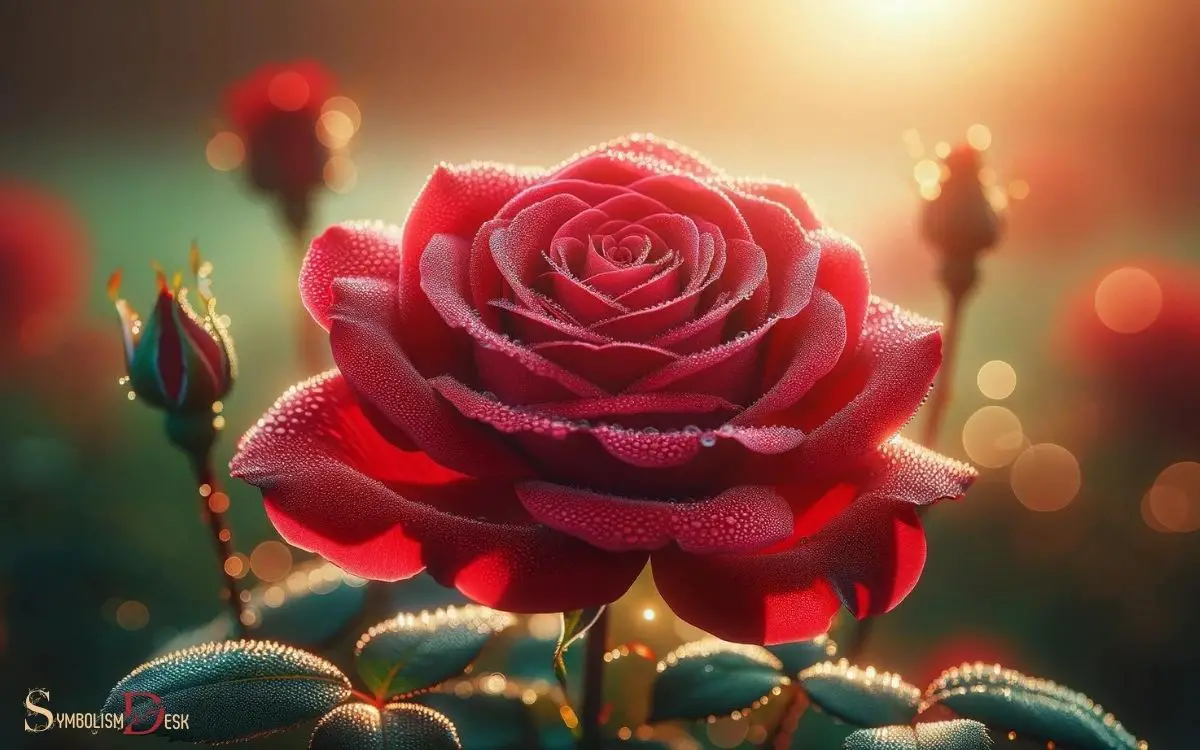Which Flower Symbolically Means Beauty? Love!
The rose is a flower that symbolically represents beauty. Renowned globally for its exquisite form and enchanting scent, it has universally come to symbolize love, honor, faith, and above all, beauty.
The symbolism of flowers, particularly in expressing beauty, has deep roots across various cultures.
The rose, with its rich array of colors and majestic bloom, is often associated with the divine beauty of Aphrodite, the Greek goddess of love and beauty, and has maintained this association throughout history.
Other flowers that are also emblematic of beauty include:
- The Orchid: Known for its exotic appearance and long-lasting bloom, symbolizes refinement and beauty.
- The Peony: With its full, lush petals, it represents a high standard of beauty and often signifies wealth and honor.
- The Calla Lily: Its elegant trumpet-shaped blooms are associated with magnificent beauty and sophistication.
Discover the timeless allure of the rose, an enduring symbol of beauty in the floral world.
Roses are the quintessential emblem of beauty in the realm of flowers. With their intricate petals and enchanting aroma, they have consistently signified love, respect, and beauty.
This article explores the historical and cultural significance of flowers, particularly roses, as a symbol of beauty.
From their mythological origins with Aphrodite to contemporary representations, the rose’s role in conveying the essence of beauty is unraveled for readers.

Key Takeaway
10 Flowers Different Symbolic Meanings
| Flower | Symbolic Meaning |
|---|---|
| Rose | Beauty and Love |
| Orchid | Beauty and Strength |
| Tulip | Perfect Love and Beauty |
| Hibiscus | Delicate Beauty |
| Lily | Purity and Refined Beauty |
| Camellia | Perfect Loveliness and Unpretending Excellence |
| Calla Lily | Magnificent Beauty |
| Azalea | Womanhood Beauty |
| Lotus | Purity and Spiritual Beauty |
| Peony | Beauty in all forms |
The Language of Flowers
Exploring the symbolism of flowers plays a key role in understanding the language of flowers. Each flower holds a unique meaning, and when combined, they can convey intricate messages.
Understanding the language of flowers involves delving into the significance attached to different blooms, colors, and arrangements.
For example, the rose symbolizes love, the lily signifies purity, and the daisy represents innocence. By learning the language of flowers, individuals can express sentiments and emotions without uttering a single word.
This symbolic language has been used for centuries to communicate deep feelings and convey hidden messages.
The language of flowers offers a rich tapestry of meanings, making it a fascinating area of study for those intrigued by the power of symbolism.
This understanding of flower symbolism seamlessly leads to the subsequent section about the ‘historical symbolism of beauty’.
Historical Symbolism of Beauty
The historical significance of beauty can be traced through the symbolic representations of various flowers in different cultures and time periods.
Throughout history, flowers have been used to convey the concept of beauty in diverse ways:
- Ancient Egypt: The lotus flower symbolized beauty and rebirth due to its ability to emerge from murky waters and bloom in pristine beauty.
- Victorian England: Flowers were used as a means of expressing emotions and sentiments, with specific blooms like roses and lilies being associated with beauty and purity.
- Chinese culture: The peony, known as the ‘king of flowers,’ has been a symbol of wealth, beauty, and honor for centuries.
- Native American traditions: The Cherokee rose was revered for its beauty and resilience, serving as a symbol of hope and strength during difficult times.
Cultural Significance in Floriography
Floriography, the language of flowers, holds immense cultural significance across various societies.
For instance, the rose represents love and passion in Western culture, while the lotus symbolizes purity and enlightenment in Eastern traditions.
These flowers not only carry deep symbolic meanings but also play a pivotal role in expressing cultural values and emotions.
Rose: Love and Passion
The rose holds a cultural significance in floriography, symbolizing love and passion in various societies around the world.
- Ancient Symbolism: The rose has been associated with love and passion since ancient times, often linked to goddesses like Aphrodite in Greek mythology and Venus in Roman mythology.
- Literary References: Renowned writers and poets, including Shakespeare and Robert Burns, have used the rose as a symbol of love and passion in their works, further embedding its significance in cultural consciousness.
- Art and Visual Representation: Throughout art history, the rose has been depicted as a symbol of love, desire, and passion, appearing in paintings, sculptures, and other visual mediums.
- Modern Significance: In contemporary culture, the rose continues to represent love and passion, making it a popular choice for gifts, romantic gestures, and expressions of affection.
This cultural significance of the rose seamlessly transitions into the subsequent section about the lotus, which symbolizes purity and enlightenment.
Lotus: Purity and Enlightenment
In cultural symbolism, the lotus represents purity and enlightenment. The lotus holds significant cultural and spiritual symbolism in many Eastern religions, including Hinduism, Buddhism, and Jainism. It’s often associated with purity, beauty, and spiritual awakening.
In Hinduism, the lotus is associated with several deities and is seen as a symbol of beauty, prosperity, and fertility.
In Buddhism, the unfolding petals of the lotus symbolize the expansion of the soul and spiritual awakening.
The roots of the lotus are in the mud, but the flower rises above the water to bloom, symbolizing the journey from darkness to enlightenment.
The lotus is also used in various meditation practices to represent the journey to inner peace and enlightenment, making it a powerful and revered symbol in Eastern cultures.
Interpreting Beauty Through Petals
Flowers have long been used as symbols to convey various meanings, and the interpretation of beauty through petals is no exception.
The rose, for example, is often associated with love and beauty, while the lotus represents purity and grace.
Understanding the significance of different flowers and their petals can provide valuable insights into the diverse interpretations of beauty across cultures.
Rose: Love and Beauty
Rose’s petals symbolize beauty and love, offering a timeless representation of these cherished emotions.
The delicate petals of a rose have long been associated with love and beauty in various cultures around the world.
The color of the petals further enhances the symbolism, with red roses representing passionate love and pink roses symbolizing admiration and gratitude. White roses, on the other hand, are often associated with purity, innocence, and new beginnings. The symbolic meaning of white roses can be seen in their frequent use at weddings and other ceremonies that mark fresh starts or sacred moments. Together, the diverse hues and their respective meanings create a rich tapestry of emotions expressed through flowers.
The soft, velvety texture of the petals adds to the allure, evoking feelings of tenderness and affection.
The intricate layers of petals in a rose blossom reflect the depth and complexity of beauty and love, reminding us that true beauty lies in the layers of the heart.
As we explore the significance of rose petals in representing love and beauty, it becomes evident that the symbolism goes beyond mere aesthetics, delving into the profound nature of human emotions and connections.
Transitioning to the subsequent section about ‘lotus: purity and grace’, it’s intriguing to uncover the diverse symbolic meanings attributed to different flowers.
Lotus: Purity and Grace
The delicate petals of the lotus, often associated with purity and grace, continue the theme of beauty and symbolism from the previous discussion of the rose.
The lotus, with its serene elegance, represents purity emerging from murky waters, signifying the beauty that can arise from difficult circumstances.
This flower holds a special place in various cultures, often symbolizing enlightenment, rebirth, and spiritual awakening.
The lotus’s ability to rise above the mud and bloom into a stunning flower is a powerful metaphor for the human journey towards inner beauty and grace.
Its exquisite appearance and rich symbolism make it a beloved choice for conveying the concept of beauty in various contexts, from art to spiritual practices. Now, let’s explore how these flowers are used in expressing beauty in floral arrangements.
Expressing Beauty in Floral Arrangements
Creating beautiful floral arrangements enhances the ambiance of any space. The art of floral arrangement allows individuals to express beauty in various ways, captivating the senses and uplifting the atmosphere.
Here are four key aspects to consider when expressing beauty in floral arrangements:
- Color Palette: Choosing the right combination of colors can evoke different emotions and enhance the overall aesthetic appeal of the arrangement.
- Texture and Form: Incorporating a variety of textures and forms adds depth and visual interest to the arrangement, creating a dynamic and captivating display.
- Balance and Proportion: Maintaining balance and proportion is crucial in creating a harmonious and visually pleasing composition.
- Symbolism: Utilizing flowers with symbolic meanings can add layers of depth and significance to the arrangement, further enhancing its beauty.
Unveiling the Beauty in Botanical Symbolism
Unveiling the beauty in botanical symbolism reveals the profound meanings behind different flowers and their representation of beauty.
Flowers have been used for centuries to convey messages and emotions, and understanding their symbolism adds depth to their beauty.
Below is a table that showcases the symbolic meanings of different flowers related to beauty:
| Flower | Symbolic Meaning of Beauty |
|---|---|
| Rose | Classic beauty and love |
| Calla Lily | Purity and innocence |
| Orchid | Exotic and delicate beauty |
| Peony | Prosperity and romance |
| Cherry Blossom | Transience and beauty |
Modern Interpretations of Beauty in Flowers
Modern interpretations of beauty in flowers showcase evolving cultural perceptions and aesthetic preferences.
In today’s society, beauty in flowers is viewed through a lens of diversity and inclusivity, reflecting the growing appreciation for different forms of beauty.
This is evident in the rise of non-traditional blooms being celebrated for their unique and unconventional beauty, challenging the conventional standards.
Additionally, the emphasis on sustainability and eco-consciousness has influenced the perception of beauty in flowers, with a preference for locally grown and seasonal blooms.
Furthermore, the intersection of technology and floral design has led to innovative and futuristic interpretations of beauty in flowers, creating a fusion of nature and modernity.
The evolving interpretations of beauty in flowers reflect a dynamic and inclusive approach to appreciating the diverse forms of floral beauty in the modern world.
Conclusion
While there are many flowers that symbolize beauty, the rose stands out as the most iconic representation of this concept.
Some may argue that other flowers, such as the lotus or orchid, also carry deep symbolism of beauty, but the universal recognition and cultural significance of the rose can’t be denied.
Its timeless elegance and captivating fragrance make it a timeless symbol of beauty in various cultures around the world.






